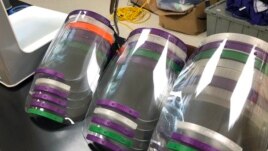02 May 2020
Students across the United States are using three-dimensional, 3D, printing equipment to make face shields for medical workers.
Some of the students are attending Camdenton High School in Camdenton, Missouri. They have been using 3D printers from a nearby middle school to produce hundreds of shields for working battling the coronavirus.
When teachers learned of serious shortages of personal protective equipment, they got the idea to use the printers to make the much-needed devices. The project began with a request from a local hospital for 150 face shields, but production quickly rose as demand kept increasing for equipment to protect health care workers.
The 3D manufactured shields differ from traditional face masks worn by doctors and nurses. The shields are placed on top of the head and have a long piece of plastic in front to completely cover the face. They guard against particles coming from an infected person's mouth or nose.

Students at Camdenton High School in Camdenton, Missouri, have been 3D printing protective face shields for health care workers battling the new coronavirus. (Photo Courtesy: Mizzou News/University of Missouri)
Camdenton Middle School received the 3D printers as part of a project with the University of Missouri's College of Education. The aim was to show middle school students how to use modern technology to solve problems affecting their communities.
Johannes Stobel is a professor of Information Science and Learning Technologies at the university. He says the project was successful in more ways than one. He said the effort helped fill a great need for protective equipment. But it also gave the students experience in using technology to attack a problem and serve the community.
"Doing hands-on projects that solve real-world problems gets students more interested in science, technology, engineering and mathematics [or STEM]," Stobel wrote.
His comments appeared on The Conversation website. He added that research has shown that students, especially girls and students of color, "become motivated and interested in engineering when it is tied to working for the social good."
Zane Foulk is a senior at Camdenton High School and a member of a local youth robotics team. He told the University of Missouri's Mizzou News he was pleased to see medical workers wearing the new face shields.
Foulk added that support in the community had been strong and the team planned on continuing production. "We have been making roughly 40 face shields a day and will keep going until we run out of material or the hospitals get what they need," he said.
In the Washington D.C. area, another high school senior helped to organize volunteers to make face shields with 3D printers. Jonah Docter-Loeb said the idea came to him as he watched news reports and heard that supplies of protective medical equipment were fast disappearing.
Doctor-Loeb is in his final year with the private Georgetown Day School. He decided to contact members of a local online community of 3D printers for help. He found a publicly available design for face shields that people could use to print from home.
In less than a month, his idea grew into an effort called Print to Protect, involving about 100 3D printers, mostly in individual homes. The group has been producing face shields for medical workers in D.C. area hospitals.
In Amarillo, Texas, another high school student is using his own 3D printer to make face shields and donate them to medical workers.
Adam Uszynski, who attends the iSchool Virtual Academy of Texas, says his idea came out of a discussion with his father, who is a doctor. Uszynski said he has already printed more than 150 face shields and has a goal to produce more than 1,000.
A report on his activities appeared on the website of Responsive Ed, a not-for-profit group that provides support to the school.
I'm Bryan Lynn.
Bryan Lynn wrote this story for VOA Learning English, based on reports from The Associated Press, the University of Missouri's College of Education, The Conservation and Responsive Ed. George Grow was the editor.
We want to hear from you. Write to us in the Comments section, and visit 51VOA.COM.
________________________________________________________________
Words in This Story
three-dimensional – adj. appearing to have length, depth and width
shield – n. a piece of equipment used as protection
mask – n. a covering for the face
motivate – v. to make someone more interested in doing something
senior – n. a student in his or her final year in college of high school
roughly – adj. about